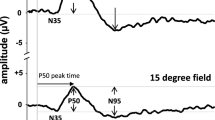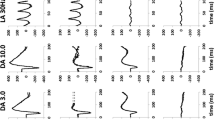Abstract
We measured the luminance threshold in eight patients (12 eyes) with retinitis pigmentosa using pattern reversal visual evoked cortical potentials (PVECPs). With decreasing pattern luminance (0 to 3.0 log unit neutral density filters), the amplitude of the p 100 component decreased linearly. Luminance threshold was determined by extrapolating the regression line of amplitude as a function of luminance to 0 μV. Our results showed that luminance threshold measured by PVECP was approximately 1.2 log units higher in patients with retinitis pigmentosa than in age-matched normal controls. Thus the PVECP may provide a way of quantitatively evaluating central retinal visual function in patients with retinitis pigmentosa
Similar content being viewed by others
Abbreviations
- RP:
-
retinitis pigmentosa
- ERG:
-
electroretinogram
- PVECP:
-
pattern visual evoked cortical potential
- NDF:
-
neutral density filter
References
De Voe R.G., Ripps, H., Vaughan H.G., Jr. Cortical responses to stimulation of the human fovea. Vision Res. 1968; 8: 135–47.
Murayama, K., Adachi-Usami, E. Visual acuity and pattern evoked retinal and cortical potentials in pigmentary retinal dystrophy. Acta. Soc. Ophthalmol Jpn. 1986; 90: 158–62.
Murayama, K., Adachi-Usami, E. Central retinal field and pattern evoked retinal and cortical potentials in pigmentary retinal dystrophy. Acta. Soc. Ophthalmol Jpn. 1986; 90: 966–69.
Cambell, F.W., Maffei, L. Electrophysiological evidence for the existence of orientation and size detectors in the human visual system. J. Physiol. 1970: 635–52.
Adachi-Usami, E. Stimulus field, element size and human visually evoked cortical potentials. Doc. Ophthalmol Proc. Series. 1980; 23: 227–35.
Adams, W.L., Arden, G.B., Behrman, J. Responses of human visual cortex following excitation of peripheral retinal rods. Some applications in the clinical diagnosis of functional and organic visual defects. Br. J. Ophythalmol. 1969; 53: 439–52.
Huber, C., Adachi-Usami, E. Scotopic visibility curve in man obtained by the VER. Adv. Exp. Med. Biol. 1972; 24: 189–98.
Wooten, B.R. Photopic and scotopic contributions to the human visually evoked cortical potential. Vision Res. 1972; 12: 1647–60.
Adachi-Usami, E., Kellermann, F.J. Spatial summation of retinal excitation as obtained by the scotopic VECP and sensory threshold. Ophthalmic Res. 1973; 5: 308–16.
Jacobson, S.G., Knighton, R.W., Levene, R.M. Dark- and light-adapted visual evoked cortical potentials in retinitis pigmentosa. Doc. Ophthalmol. 1985; 60: 189–96.
Author information
Authors and Affiliations
Rights and permissions
About this article
Cite this article
Murayama, K., Adachi-Usami, E. Pattern visual evoked cortical potential measurement of luminance threshold in retinitis pigmentosa. Doc Ophthalmol 71, 271–277 (1989). https://doi.org/10.1007/BF00170976
Issue Date:
DOI: https://doi.org/10.1007/BF00170976




